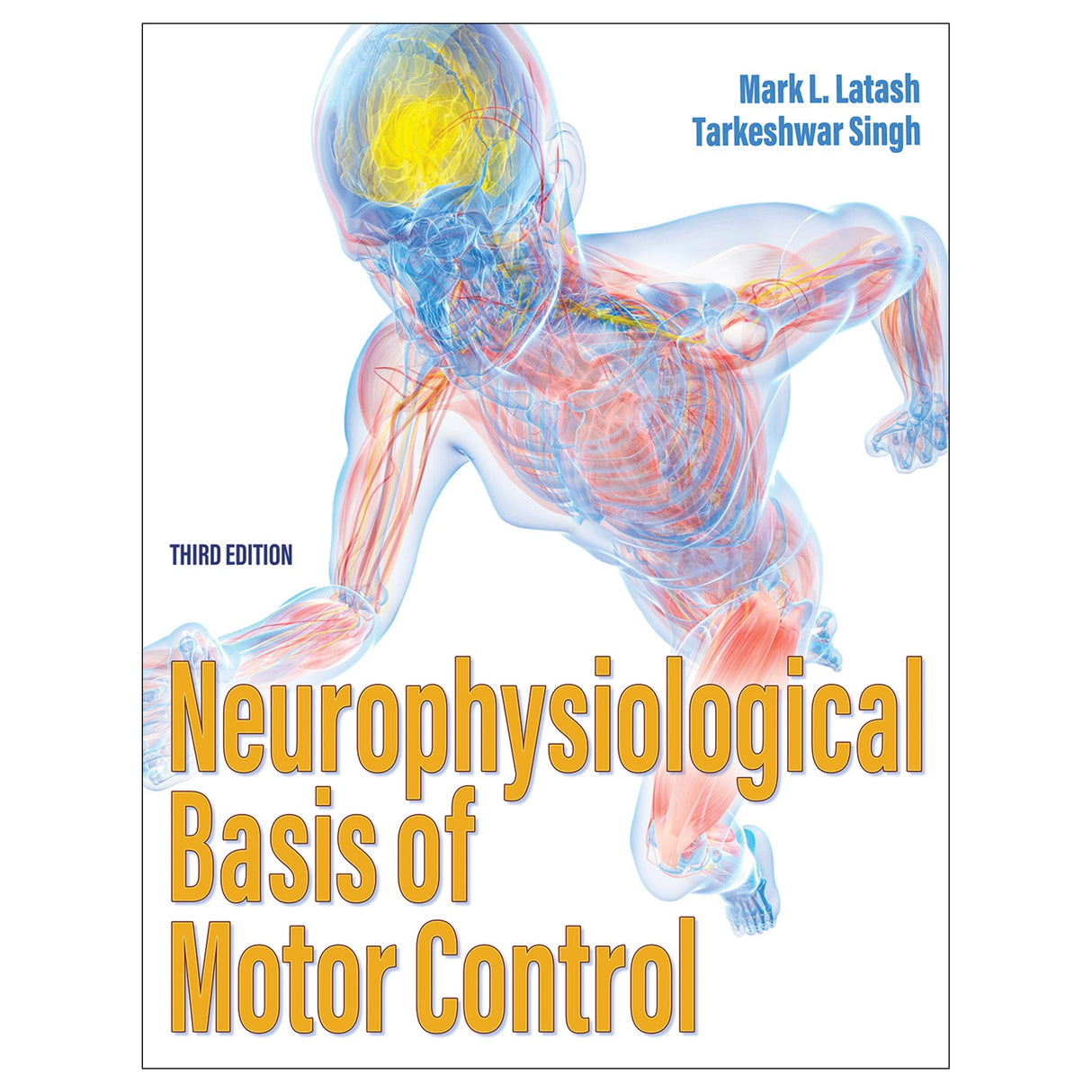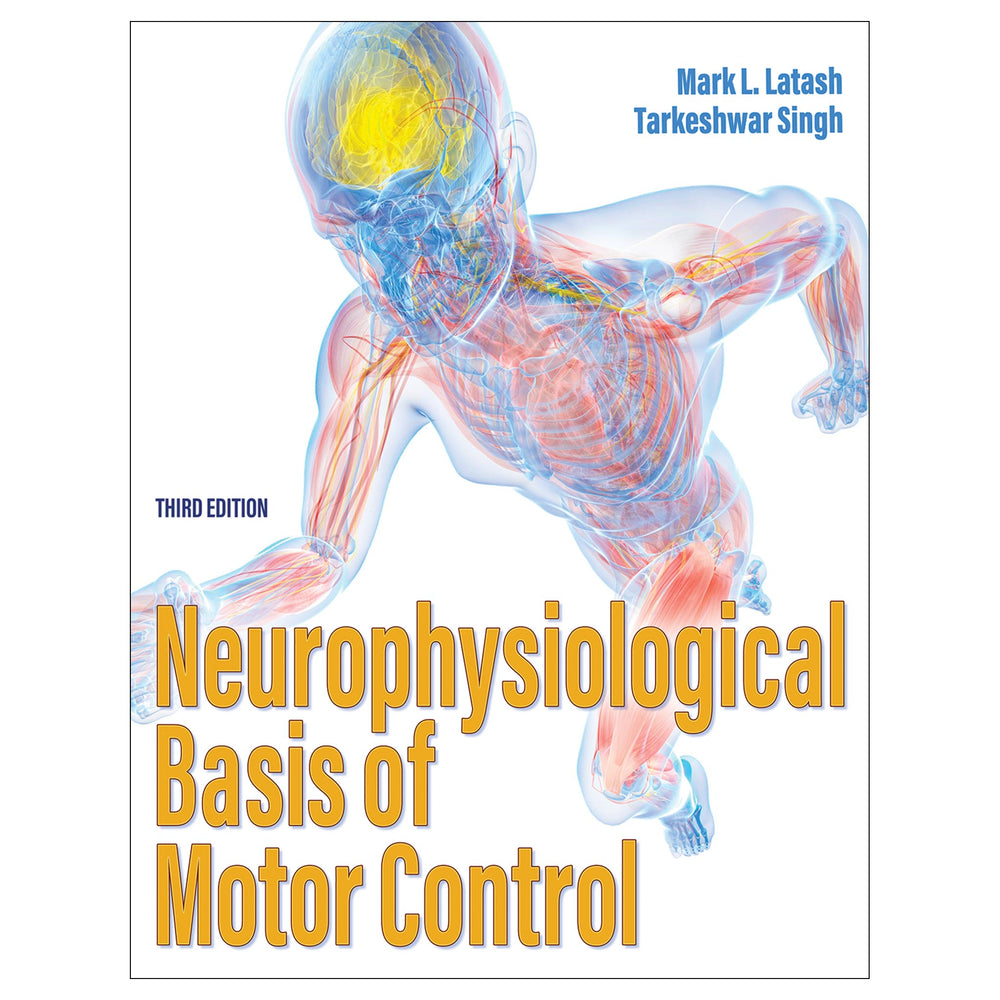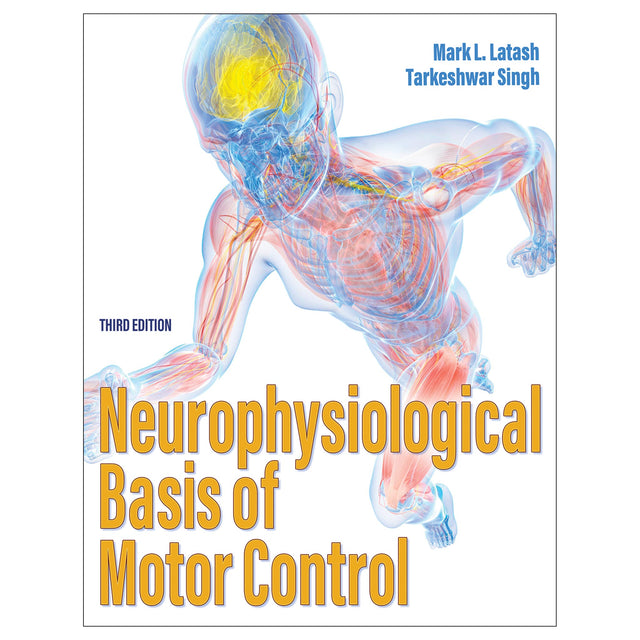Neurophysiological Basis of Motor Control-3rd Edition
Author: Mark L. Latash, Tarkeshwar Singh
$119.00 USD
Author Mark Latash, PhD—founding editor of the journal Motor Control and past president of the International Society of Motor Control (ISMC)—combines his expertise with the experience of new coauthor Tarkeshwar Singh, PhD, director of the Sensorimotor Neuroscience and Learning Laboratory at Penn State University. In the third edition of this book, previously titled Neurophysiological Basis of Movement, the authors present the following:
- New chapters on motor learning and sensorimotor integration
- Expanded sections dedicated to the role of different sensory modalities in motor control, kinesthetic perception, and action–perception interactions
- An exploration of the basis of neuroanatomy, aging and development, motor disorders, and basic concepts such as coordination, reflexes, voluntary movement, sensation, and perception
Neurophysiological Basis of Motor Control, Third Edition, deepens students’ knowledge of the link between the brain and movement with basic facts about neural motor control, neuroanatomy, and movement disorders. The text will help usher in a new era in the study of motor control, promoting independent thinking and sharing thought-provoking ideas on current theories of motor control and coordination.
Audience
A text for upper undergraduate and graduate courses on neural control of movement and movement disorders. A reference for specialists in motor behavior, neuroscience, and motor rehabilitation.1.1 Brief History of Movement Studies
1.2 Evolution of Movements and Nikolai Bernstein’s Theory
1.3 Motor Control and Laws of Nature
Part I. Excitable Cells and Their Communication
Chapter 2. Membranes, Particles, and Equilibrium Potentials
2.1 The Biological Membrane
2.2 Movement in a Solution
2.3 Concentration of Water: Osmosis
2.4 Movement of Ions: The Nernst Equation
Chapter 3. Action Potential
3.1 Creation of a Membrane Potential
3.2 Basic Features of the Action Potential
3.3 Mechanisms of Generating an Action Potential
Chapter 4. Information Conduction and Transmission
4.1 Conduction of an Action Potential
4.2 Myelinated Fibers
4.3 The Structure of a Neuron
4.4 Information Coding in the Nervous System
4.5 Synaptic Transmission
4.6 Neurotransmitters
4.7 Temporal and Spatial Summation
Chapter 5. Skeletal Muscle
5.1 Skeletal Muscle Structure
5.2 Myofilaments
5.3 Neuromuscular Synapse
5.4 Mechanisms of Contraction
5.5 Types of Muscle Contractions
5.6 Elements of Mechanics
5.7 Force–Length and Force–Velocity Relations
5.8 External Regimes of Muscle Contraction
Chapter 6. Peripheral Receptors
6.1 General Classification and Properties of Receptors
6.2 Muscle Spindles
6.3 The Gamma-System
6.4 Golgi Tendon Organs
6.5 Other Muscle Receptors
6.6 Articular Receptors
6.7 Cutaneous Receptors
6.8 Signals From Peripheral Receptors
Chapter 7. Motor Units and Electromyography
7.1 The Motor Unit
7.2 Fast and Slow Motor Units
7.3 The Henneman Principle
7.4 Functional Roles of Different Motor Units
7.5 Electromyography
7.6 Processing Electromyographic Signals
Problems for Part I
Part II. Neuroanatomical Foundations of Motor Control
Chapter 8. Cerebral Cortex
8.1 Structure of the Cerebral Cortex
8.2 Cells in the Cerebral Cortex
8.3 Premotor Cortex and Supplementary Motor Area
8.4 Primary Motor Cortex
8.5 Efferent Output From the Cortical Motor Areas
8.6 Afferent Input Into the Cortical Motor Areas
8.7 Hemispheric Lateralization in the Cortical Motor Areas
8.8 Preparation for a Voluntary Movement
8.9 Neuronal Population Vectors
8.10 Encoding Movement Parameters in the M1
8.11 Brain–Machine Interfaces
Chapter 9. Basal Ganglia
9.1 Anatomy of the Basal Ganglia
9.2 Inputs and Outputs of the Basal Ganglia
9.3 Direct and Indirect Pathways Within the Basal Ganglia
9.4 Dopamine Modulation of Basal Ganglia Circuits
9.5 Motor Circuits Involving the Basal Ganglia
9.6 Activity of the Basal Ganglia During Movements
9.7 Movement Disorders Associated With the Basal Ganglia
9.8 Other Functions of the Basal Ganglia
Chapter 10. Cerebellum
10.1 Overall Structure of the Cerebellum
10.2 Inputs and Outputs of the Cerebellum
10.3 Pathways Within the Cerebellum
10.4 Distinct Cerebellar Regions Control Discrete Motor Functions
10.5 Cerebellar Control of Movement
10.6 Consequences of Cerebellar Lesions on Movements
10.7 Cerebellar Contribution to Motor Learning
10.8 Cerebellar Interactions With the Basal Ganglia and Cortex
Chapter 11. Brainstem and Extrapyramidal Tracts
11.1 Brainstem Anatomy
11.2 Reticular Formation
11.3 Superior Colliculus
11.4 Red Nucleus
11.5 Vestibular Nuclei
11.6 Cranial Nerves
11.7 Descending Tracts
Problems for Part II
Part III. Sensory Basis of Motor Control
Chapter 12. Central Processing of Somatosensory Information
12.1 First-Order Neurons
12.2 Second-Order Neurons
12.3 Third-Order Neurons
12.4 Proprioceptive System
12.5 Primary and Secondary Somatosensory Cortex
12.6 Integration of Somatosensory Input With Other Sensory Modalities
12.7 Injuries to Somatosensory Pathways
Chapter 13. Vestibular and Auditory System
13.1 Transduction in the Vestibular System
13.2 Vestibular Afferents Respond to Head Motion
13.3 Central Projections From the Otolith Organs and Semicircular Canals
13.4 Central Pathways That Stabilize Gaze, Posture, and Head Movements
13.5 Peripheral Auditory System
13.6 Central Auditory Projections From the Cochlea
13.7 Auditory Integration
13.8 Auditory Thalamus and Cortex
13.9 Auditory Cortex and Limb Motor Control
Chapter 14. Visual System
14.1 Structure of the Eye
14.2 Structure of the Retina
14.3 Rods and Cones
14.4 Optic Nerve, Tracts, and Radiations
14.5 Striate Cortex
14.6 Retinotopic Organization of V1
14.7 Extrastriate Cortex
14.8 Neurons of the Two Visual Streams
14.9 Visual Deficits Due to Area-Specific Visual System Damage
14.10 Ocular Movements
Problems for Part III
Part IV. Reflexes and Reflex-Like Movements
Chapter 15. Reflexes
15.1 Definition of a Reflex
15.2 Reflex Arc, Gain, and Latency
15.3 Reflex Classifications
15.4 Conditioned Reflexes
Chapter 16. Excitation and Inhibition Within the Spinal Cord
16.1 The Spinal Cord
16.2 Excitation Within the Central Nervous System
16.3 Postsynaptic Inhibition
16.4 Recurrent Inhibition and Renshaw Cells
16.5 Reciprocal Inhibition
16.6 Presynaptic Inhibition
16.7 Persistent Inward Currents
Chapter 17. Monosynaptic Reflexes
17.1 H-Reflex and M-Response
17.2 Tendon Tap Reflex (T-Reflex)
17.3 Effects of Voluntary Muscle Activation on Monosynaptic Reflexes
17.4 F-Wave
Chapter 18. Oligosynaptic and Polysynaptic Reflexes
18.1 Oligosynaptic Reflexes
18.2 Polysynaptic Reflexes
18.3 Flexor Reflex
18.4 Tonic Stretch Reflex
18.5 Tonic Vibration Reflex
18.6 Interaction Among Reflex Pathways
18.7 Inter-Joint and Inter-Limb Reflexes
Chapter 19. Long-Loop Reflexes and Reflex-Like Reactions
19.1 Preprogrammed Reactions
19.2 Preprogrammed Reactions Versus Stretch Reflexes
19.3 Afferent Sources of Preprogrammed Reactions
19.4 Preprogrammed Reactions During Movement Perturbations
19.5 Basic Features of Preprogrammed Reactions
19.6 Preprogrammed Corrections of Vertical Posture
19.7 Corrective Stumbling Reactions
Problems for Part IV
Part V. Control and Coordination of Goal-Oriented Movements
Chapter 20. Voluntary Control of a Single Muscle
20.1 What Is Voluntary Movement?
20.2 Feedforward and Feedback Control
20.3 Servo Control
20.4 Servo Hypothesis
20.5 α-γ Coactivation
20.6 Voluntary Activation of Muscles
20.7 Equilibrium-Point Hypothesis
Chapter 21. General Issues of Motor Control
21.1 Force Control
21.2 Engrams and the Generalized Motor Program
21.3 Internal Models
21.4 Equilibrium-Point Hypothesis: Main Ideas
21.5 Equilibrium-Point Hypothesis: Subtle Details
21.6 Dynamic Systems Approach
Chapter 22. Motor Synergies
22.1 The Problem of Motor Redundancy
22.2 Optimization Approaches
22.3 Bernstein’s Level of Synergies
22.4 Uniting Muscles Into Groups
22.5 Principle of Abundance
22.6 Ensuring Stability of Movements
22.7 Uncontrolled Manifold Hypothesis
Chapter 23. Patterns of Single-Joint Movements
23.1 Isotonic Movements and Isometric Contractions
23.2 Task Parameters and Performance Variables
23.3 Kinematic Patterns During Single-Joint Isotonic Movements
23.4 EMG Patterns During Single-Joint Isotonic Movements
23.5 EMG Patterns During Single-Joint Isometric Contractions
23.6 Dual-Strategy Hypothesis
23.7 Single-Joint Movements Within the Equilibrium-Point Hypothesis
Chapter 24. Multijoint Movement
24.1 Two Issues With Controlling Natural Reaching Movements
24.2 Interjoint Reflexes
24.3 Multijoint Coordination by the Spinal Cord
24.4 Supraspinal Mechanisms
24.5 Neural Control Variables for Multijoint Movements
24.6 Equilibrium-Trajectory Hypothesis
24.7 Hierarchical Control With Spatial Referent Coordinates
24.8 Multijoint Synergies
Chapter 25. Postural Control
25.1 Vertical Posture
25.2 Postural Sway
25.3 Role of the Vestibular System
25.4 Role of Vision
25.5 Role of Proprioception
25.6 Anticipatory Postural Adjustments
25.7 Corrective Postural Reactions
25.8 Postural Synergies
Chapter 26. Locomotion
26.1 Two Approaches to Locomotion
26.2 Central Pattern Generator
26.3 Locomotor Centers
26.4 Spinal Locomotion
26.5 Spinal Control of Locomotion in Humans
26.6 Gait Patterns
26.7 Dynamic Pattern Generation
26.8 Step Initiation
26.9 Corrective Stumbling Reaction
Chapter 27. Prehension
27.1 Hand Joints and Muscles
27.2 Cortical Representations of the Hand
27.3 Indices of Finger Interaction
27.4 Multifinger Synergies in Pressing Tasks
27.5 Grasping
27.6 Prehension Synergies and Principle of Superposition
Problems for Part V
Part VI. Sensorimotor Integration for Perception and Action
Chapter 28. Kinesthetic Perception
28.1 Sensation and Perception
28.2 Weber-Fechner Law
28.3 Ambiguity of Sensory Information
28.4 Afferent and Efferent Components of Perception
28.5 Vibration-Induced Kinesthetic Illusions
28.6 Distorted Efferent Copy and Preconceptions
28.7 Sense of Effort
28.8 Stability of Percepts
28.9 Perception–Action Coupling
Chapter 29. Multisensory Integration
29.1 Spatial Multisensory Integration for Limb Motor Control
29.2 Temporal Multisensory Integration for Limb Motor Control
29.3 Coordinate Frames for Limb Motor Control
29.4 Postural Balance and Motion Perception
29.5 Neural Correlates of Multisensory Integration
Chapter 30. Visual Perception and Action
30.1 Two Visual Streams
30.2 Magnocellular and Parvocellular Ganglion Cells and Streams
30.3 Motion Processing in the Cortex
30.4 Color, Object, and Face Recognition in the Ventral Stream
30.5 Roles of Dual Streams for Reach-to-Grasp Movements
30.6 Neural Structures Involved in Oculomotor Control
30.7 Frontoparietal Cortical Areas Involved in Eye–Hand Coordination
30.8 Eye and Hand Coordination for Movements Starting From Rest
30.9 Eye and Hand Coordination During Movement
30.10 Eye and Hand Coordination While Intercepting Moving Targets
Problems for Part VI
Part VII. Emerging, Evolving, and Adapting Movements
Chapter 31. Fatigue
31.1 Fatigue and Its Contributors
31.2 Muscular Mechanisms of Fatigue
31.3 Spinal Mechanisms of Fatigue
31.4 Supraspinal Mechanisms of Fatigue
31.5 Adaptive Changes During Fatigue
31.6 Abnormal Fatigue
Chapter 32. Effects of Aging
32.1 General Features of Movements in Elderly Persons
32.2 Changes in Muscles and Motor Units
32.3 Muscle Reflexes in Elderly Persons
32.4 Changes in Sensory Function
32.5 Muscle Activation Patterns During Fast Movements
32.6 Changes in Posture and Gait
32.7 Hand Function in Elderly Persons
32.8 Changes in Motor Synergies
32.9 Adaptive Changes in Motor Patterns
32.10 Effects of Training
Chapter 33. Typical and Atypical Development
33.1 Humans at Birth
33.2 Motor Milestones During Typical Development
33.3 Exploration and Emergent Motor Patterns
33.4 Development of Motor Synergies
33.5 Down Syndrome
33.6 Effects of Practice in People with Down Syndrome
33.7 Autism
33.8 Developmental Coordination Disorder
Chapter 34. Motor Learning
34.1 Adaptation, Learning, and Memory
34.2 Muscle Memory
34.3 Habituation of Reflexes
34.4 Conditioned Reflexes
34.5 Operant Conditioning and Learning Spinal Reflexes
34.6 Short-Term and Long-Term Memory
34.7 Adaptation to Unusual Force Fields
34.8 Motor Skills
34.9 Learning Motor Synergies
34.10 Stages in Motor Learning
34.11 Effects of Practice on Cortical Representations
Problems for Part VII
Part VIII. Motor Disorders
Chapter 35. Peripheral Muscular and Neurological Disorders
35.1 Myopathies and Neuropathies
35.2 Muscular Dystrophies
35.3 Continuous Muscle Fiber Activity Syndromes
35.4 Myasthenia Gravis
35.5 Mononeuropathies
35.6 Multiple Mononeuropathies
35.7 Polyneuropathies
35.8 Radiculopathies
Chapter 36. Spinal Cord Injury and Spasticity
36.1 Consequences of Spinal Cord Injury
36.2 Signs and Symptoms of Spasticity
36.3 Possible Mechanisms of Spasticity
36.4 Defining Muscle Tone
36.5 Treatment of Spasticity
Chapter 37. Disorders Involving the Basal Ganglia
37.1 Clinical Features of Parkinson's Disease
37.2 Voluntary Movements in Parkinson's Disease
37.3 Vertical Posture and Locomotion in Parkinson's Disease
37.4 Motor Synergies in Parkinson's Disease
37.5 Treatment of Parkinson’s Disease
37.6 Huntington’s Chorea
37.7 Hemiballismus
37.8 Dystonia
37.9 Tardive Dyskinesia
Chapter 38. Cerebellar Disorders
38.1 Consequences of Cerebellar Injuries in Animals
38.2 Consequences of Cerebellar Disorders in Humans
38.3 Abnormalities of Stance and Gait
38.4 Voluntary Movements in Cerebellar Disorders
38.5 Cerebellar Tremor
38.6 Ataxias
38.7 Changes in Motor Synergies
38.8 Cerebellar Cognitive Affective Syndrome
Chapter 39. Cortical Disorders
39.1 Consequences of Lesions of Different Cortical Lobes
39.2 Stroke
39.3 Myoclonus
39.4 Tics
39.5 Tourette Syndrome
39.6 Williams Syndrome
Chapter 40. Systemic Disorders
40.1 Amyotrophic Lateral Sclerosis
40.2 Multiple Sclerosis
40.3 Multisystem Atrophy
40.4 Essential Tremor
40.5 Cerebral Palsy
40.6 Wilson’s Disease
Chapter 41. Motor Rehabilitation
41.1 Do “Normal Movements” Exist?
41.2 Changes in CNS Priorities
41.3 Neural Plasticity
41.4 Adaptive Changes in Motor Patterns
41.5 Consequences of Amputation
41.6 Functional Electrical Stimulation
41.7 Constraint-Induced and Discomfort-Induced Therapies
41.8 Brain–Computer Interface
41.9 Practical Considerations
Problems for Part VIII
Eye and Hand Coordination While Intercepting Moving Targets
Preprogrammed Reactions Versus Stretch Reflexes

All ancillaries are free to adopting instructors through HKPropel.
Presentation package. Features more than 200 PowerPoint slides of text, artwork, and tables from the book that can be used for class discussion and presentation. The slides in the presentation package can be used directly within PowerPoint or printed to make handouts for students. Instructors can easily add, modify, and rearrange the order of the slides.
Multiple-choice answers. Instructors receive answers to the multiple-choice problems found in the book.





